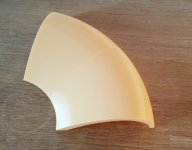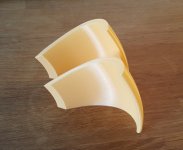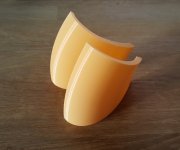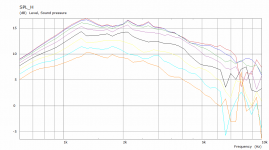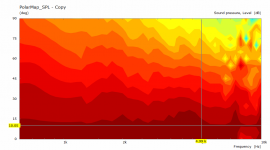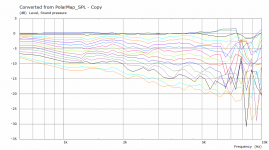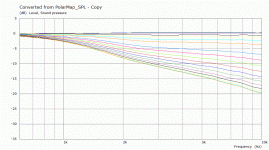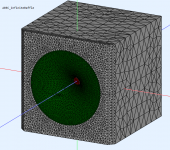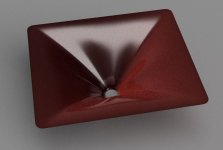What can I say - Bravo!
Strange. That's my thought every time i see you post something new with your great piece of freeware. Same thoughts for Kimmo's VituixCad as well. Your waveguide really makes things easy to work with. Here's maybe 1.5 hours worth of sim showing filtered and unfiltered response on axis with passive crossover and optimized for >2m listening distance:
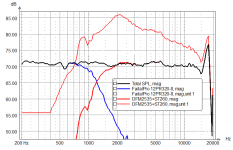
Showing pics from LspCAD since it's easier to see or at least i'm more used to it.
Given how consistent off axis frequency response is to on axis in ST260, this will be a piece of cake once everything is in place.
Last edited:
In the ABEC project I just posted, in the 'solving.txt' please correct the IB offset to 81.973 mm:
There's still a minor bug, as I've just found out.
Code:
Infinite_Baffle
Subdomain=2; Position=z offset=81.973mmZvu - it's enlightening to see how much detail does a shorter time window actually hides (smoothes out). Here especially around the resonance.
Yeah. That's what bugged me too so i needed to measure just to see what it looks like.
I've used ground plane and that same 13ms gate combined at 250Hz for 12pr320. I easily measured standing wave null at 190Hz (a product of not enough damping material on the bottom of the cabinet. Also, factory curves, both frequency amplitude and impedance, can be thrown out the window. Everything measures scary. It makes me work more on the crossover but i get better results in the end because of it.
I've used ground plane and that same 13ms gate combined at 250Hz for 12pr320. I easily measured standing wave null at 190Hz (a product of not enough damping material on the bottom of the cabinet. Also, factory curves, both frequency amplitude and impedance, can be thrown out the window. Everything measures scary. It makes me work more on the crossover but i get better results in the end because of it.
Last edited:
- I've tried the second cheapest filament I have in stock (the cheapest was the gray one I used so far). It's just perfect 🙂
(0.2 mm layer, 0.4 mm nozzle, printing two at a time)
(0.2 mm layer, 0.4 mm nozzle, printing two at a time)
Attachments
Last edited:
Marcel,
Thank you very much for those sims, they were very interesting. It is fascinating to see the resonance from the waveguide cavity. I think that foam just might be a great idea to tame that. And, yes I agree with your main take-aways. What you suggested is what I have always done.
I certainly wish that I had the tools that you have now back in the days when I did simulations. But then the older gents in the business back then said the same things to me. The "art" of loudspeaker design has evolved tremendously over the decades. That's I why I just don't understand the "nostalgia" craze for old designs. Just makes no sense to me.
Thank you very much for those sims, they were very interesting. It is fascinating to see the resonance from the waveguide cavity. I think that foam just might be a great idea to tame that. And, yes I agree with your main take-aways. What you suggested is what I have always done.
I certainly wish that I had the tools that you have now back in the days when I did simulations. But then the older gents in the business back then said the same things to me. The "art" of loudspeaker design has evolved tremendously over the decades. That's I why I just don't understand the "nostalgia" craze for old designs. Just makes no sense to me.
Last edited:
I started before I saw the edit so the enclosure was made 350mm deep. For looking at the horizontal response there is no real need to model the full baffle as it leads to needing half symmetry and a lot more elements which bogs the sim down considerably.Let's do 40cm depth.
So w*h*d-35*100*40.
This is what was simulated. Cutting the waveguide into the baffle was more difficult than usual and I used the interface mabat generated. These 3D combinations are very finicky about all the vertices lining up and above 5K there is too much difference and the sim degenerates into garbage. Below 5K it is much more reliable.
I tried this and I couldn't find an easy or working solution. The shape of the diffraction response is quite close to that seen in the ABEC sim so Vituix would be a good way to check width for any issues before testing or simulating depth.Just an idea - perhaps you could use simulated frequency responses obtained from ABEC/VACS for an infinite baffle and use those in VituixCAD and its diffraction simulator? Would that work?
Yes it's 2D only no depth.I'm not sure VituixCad does 3D sim. It sees baffle as 2D if i remember correctly.
The main difference with a baffle is that the directivity is extended lower and with a big enough roundover the diffraction is still well controlled. The freestanding guide is somewhere in between with immunity to nearby objects upsetting the pattern being it's main benefit. If the woofer or mids below the freestanding guide work well as a directivity match the lower controlled directivity from the finite baffle might not be worth trading the smoother response for.
Attachments
I really should implement a placement into an enclosure as an option into Ath. It's actually pretty easy with Gmsh scripts, including variable mesh density, etc. I know I already prepared the tool for this somehow. The hardest part now is to recall how was the code meant when I wrote it. After maybe a year of not coding Ath regularly, I forgot most of it...
It would be awesome if you could find the time to do it as getting the mesh all in one would solve a lot of the trial and error that results from cutting and slicing things back together 🙂 Given the performance of freestanding axisymmetric guides I can understand why it has not been a priority.I really should implement a placement into an enclosure as an option into Ath.
I started before I saw the edit so the enclosure was made 350mm deep. For looking at the horizontal response there is no real need to model the full baffle as it leads to needing half symmetry and a lot more elements which bogs the sim down considerably.
This is what was simulated...
Thanks fluid.
Yes, i edited to be able to get to a 100 liters since some midwoofers demand larger volume. I think 5cm difference will make no significant difference for sim.
Even with issues you mention, your sims speak for themselves. Freestanding waveguide proves as the best option - possibly the simplest to implement too.
Last edited:
...It is fascinating to see the resonance from the waveguide cavity. I think that foam just might be a great idea to tame that....
Wouldn't foam, that is thick enough to damp the resonance at 800Hz attenuate everything above that significantly ?
Just for the record, I saw measurements of a pair (with ST260) and it was quite poor, hardly usable. Very disappointing, basically no output quality control.Any experience with the .Kartesian Cmp35_vPA, anyone?
Last edited:
I decided to release the code for my Tritonia waveguide: https://at-horns.eu/ext/Tritonia.zip
Licensed under CC BY-NC-SA 4.0.
It's easily scalable for any throat size.
Licensed under CC BY-NC-SA 4.0.
It's easily scalable for any throat size.
Attachments
Last edited:
I decided to release the code for my Tritonia waveguide: https://at-horns.eu/ext/Tritonia.zip
Licensed under CC BY-NC-SA 4.0.
It's easily scalable for any throat size.
Thanks for the gift!
When you say it is scalable to any throat size, you mean it's also scalable in size? IE. would this be suitable to match a 6.5" or 8" woofer when make it with a width around those sizes?
Probably not designed for it, but what about using a dome tweeter instead a CD?
Thanks again! for ATH and Tritonia!
With the code published, you have all the power of Ath&ABEC at your disposal.
-------------------------------------------------------
; Tritonia Waveguide
; (C)2021 Marcel Batík licensed under CC BY-NC-SA 4.0
; Ath version 4.7
; -------------------------------------------------------
Throat.Diameter = 36 ; [mm]
Throat.Angle = 4.2 ; [deg]
Throat.Profile = 1
Length = 135 ; [mm]
Coverage.Angle = 48.5 - 7*cos(2*p)^5 - 16*sin(p)^12
Term.s = 0.7 + 0.2*cos(p)^2
Term.n = 3.7
Term.q = 0.995
Morph.TargetShape = 1
Morph.FixedPart = 0.0
Morph.Rate = 3
Morph.CornerRadius = 18 ; [mm]
Source.Shape = 1
Source.Curv = 0
Source.Radius = -1
Source.Velocity = 1
; -------------------------------------------------------
; Mesh Setting
; -------------------------------------------------------
; ABEC
;Mesh.AngularSegments = 80
;Mesh.LengthSegments = 30
;Mesh.CornerSegments = 4
; Fusion 360
Mesh.AngularSegments = 60
Mesh.DepthSegments = 20
Mesh.CornerSegments = 5
Mesh.ThroatResolution = 4.0 ; [mm]
Mesh.InterfaceResolution = 9.0 ; [mm]
Mesh.InterfaceOffset = 5.0 ; [mm]
; ...
-------------------------------------------------------
; Tritonia Waveguide
; (C)2021 Marcel Batík licensed under CC BY-NC-SA 4.0
; Ath version 4.7
; -------------------------------------------------------
Throat.Diameter = 36 ; [mm]
Throat.Angle = 4.2 ; [deg]
Throat.Profile = 1
Length = 135 ; [mm]
Coverage.Angle = 48.5 - 7*cos(2*p)^5 - 16*sin(p)^12
Term.s = 0.7 + 0.2*cos(p)^2
Term.n = 3.7
Term.q = 0.995
Morph.TargetShape = 1
Morph.FixedPart = 0.0
Morph.Rate = 3
Morph.CornerRadius = 18 ; [mm]
Source.Shape = 1
Source.Curv = 0
Source.Radius = -1
Source.Velocity = 1
; -------------------------------------------------------
; Mesh Setting
; -------------------------------------------------------
; ABEC
;Mesh.AngularSegments = 80
;Mesh.LengthSegments = 30
;Mesh.CornerSegments = 4
; Fusion 360
Mesh.AngularSegments = 60
Mesh.DepthSegments = 20
Mesh.CornerSegments = 5
Mesh.ThroatResolution = 4.0 ; [mm]
Mesh.InterfaceResolution = 9.0 ; [mm]
Mesh.InterfaceOffset = 5.0 ; [mm]
; ...
For a 1.4" throat I think it requires something a little different. Still working on that. So none of those, as CE*** are all 1" throat.Which model are you using for your HF1440? The CE460?
- Home
- Loudspeakers
- Multi-Way
- Acoustic Horn Design – The Easy Way (Ath4)
